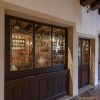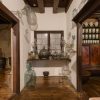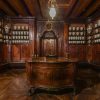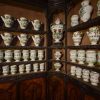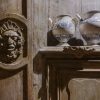The «Ai Do San Marchi» pharmacy was located in Campo San Stin in Venice on the corner of Calle Donà. The earliest records of its existence date back to the second half of the seventeenth century: we know that in 1679 it was owned by Orazio Moscatello. Around mid-eighteenth century the owner was Bernardo Saletti who was responsible for the complete refurbishing of the premises and its furnishings. Datable to that period are in fact the furniture, most of the majolica vases, and the objects in the finest Murano glass which are now at Ca‘ Rezzonico. In 1908 the widow of the last owner, Anna Mazzoni Costa, decided to sell the furnishings, which were subsequently purchased by the Parisian antiques dealer Raoul Heilbronneur, who, unable to transfer the entire acquisition to France, at the suggestion of the Venetian sculptor Antonio Dal Zotto, preferred to donate it to the Musei Civici di Venezia.
The pharmacy consists of three intercommunicating rooms. The first, the shop itself, is fitted with elegant furnishings in dark burl walnut; the decorated majolica vases on the shelves designed to contain the spices and the materials needed for the preparation of medications, are the work of the Cozzi manufacture in Venice. The two largest two-handled vessels, placed symmetrically in the corners of the far wall, bear the emblem of the pharmacy: two facing lions holding the open Gospel, the symbol of the protector of Venice, the evangelist Mark. Also noteworthy is the stylish desk with its refined convex lines.
The second room is occupied by the workshop, with a fireplace and a stove, as well as alembics in the most diverse forms, in the thinnest glass from the Murano furnaces.
The third room is the back room of the pharmacy. Here the walls are completely covered with panelling in painted pine wood, enriched with carved capitals and rococo decorative elements. The shelves are filled with other white majolica vases decorated with blue markings, evidently part of the furnishings of the previous pharmacy before the renovations carried out by Saletti, and additional Murano glass jars. Also interesting are the two large mortars, used to grind the raw materials.
